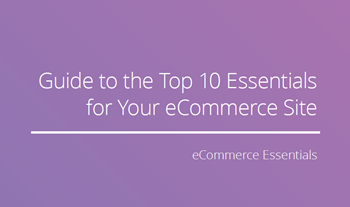The eCommerce sector is booming at an unprecedented rate, poised to hit a whopping $4.5 trillion by 2021. It seems that modern consumers have fully embraced online shopping due to the convenience of doing everything with just a few clicks of the finger.
However, they are also pickier and more spoilt for choice than ever before. Brands have to pull them in, retain their attention, and carefully guide them towards conversion. To accomplish these goals, it is not enough to just build a virtual store and hope for the best. You need to refine the user experience (UX), the Holy Grail of today’s eCommerce.
Despite what some assume, this concept encompasses much more than web design. In fact, it far transcends your digital store altogether.
1. Functionality comes first
Keeping up with prominent key trends is the name of the eCommerce game.
To get on top of it, businesses must learn to separate passing fads from novelties that have staying power. Parallax scrolling, automatic image sliders, and video backgrounds were surrounded by immense buzz when they first appeared, but they ended up falling into the former category. This is because they are fleshy and fancy elements that add little to the website’s functionality.
The best UX design must first embody functionality and then infuse pages with visual appeal. Namely, bespoke visuals can make a nice first impression, but that impression can quickly fade away. What you have to offer is great product categories, handy information, smooth navigation, and a quick checkout process.
One study, for example, found that 88% of shoppers deem detailed product content vital to their purchase decision. This is not to say that aesthetics are unimportant, merely that they must never overshadow functionality.
2. The art of personalization
One of the key trends shaping eCommerce is personalization. It is an ongoing process of fine-tuning, which holds the potential to elevate the overall UX and boost engagement and conversion rates. To get the ball rolling, you need to dig into consumer data related to past behavior and feedback. Use advanced analytics tools to extract only the valuable insights.
Start by offering personalized product recommendations. Next, add trending and “customers who bought this product also viewed” sections that Amazon pioneered and still champions. You can also send personalized emails newsletter with data-backed suggestions and notifications.
And if you think people shun emails, you are wrong— 91% of Americans stress their receptiveness to promotional emails.
Of course, to implement these changes (save for emails), you would have to do an extensive redesign of your storefront. Free website builders and tools are fine and all, but it is hard to achieve that killer professional impression with them. Thus, consider hiring an eCommerce development expert to really take your store experience to the next level. The investment is likely to pay dividends in the long run.
3. Review navigation and the checkout process
Along similar lines, easy product search and navigation are paramount to fostering a great UX.
These actions should be possible to perform in many different ways, according to individual preferences. Thus, make sure to include functionalities that narrow down the list of items of interest. Let people save items to review later— usually, this feature takes the form of a wish list.
Furthermore, prevent unpleasant surprises at the checkout stage. In general, people want it to involve as few steps as possible and most drop out due to unexpected costs and steep shipping prices. Among other major reasons for abandonment are complicated processes of setting an account and inconvenient return policies.
While avoiding these pitfalls, try to make the transition between the shopping cart and overall shopping experience smooth. Store information on those who log in— that way, they don’t have to fill everything in manually. Even better, enable them to log in with an existing social media account. Finally, ponder integrating a guest checkout option and make data validation as quick and efficient as possible.
4. You need a smart multiple-channel strategy
These days, people tend to use multiple devices over the course of the buyer journey. Therefore, eCommerce businesses need to avoid losing business when a move from one channel to another occurs.
Notice that the bulk of online shopping time (60%) is now spent on mobile devices, yet these devices only account for 15% of purchases. These findings reveal a serious lack of proper mobile UX optimization and suggest you can gain a powerful edge by focusing your efforts here.
So, adhere to new rules of the game put forward by Google’s Mobile-First indexing and improve the mobile-friendliness of your storefront. It might also be wise to focus on dedicated smartphone apps that are constantly gaining traction and represent one of the most convenient methods for online shopping.
At the same time, do not overlook channels like social media. A growing number of shoppers express willingness to make purchases directly from social hubs and admit they are influenced by social media recommendations. So, cast a wide net. That is the best shot you have to establish a strong foothold in such an immensely competitive landscape.
5. Get ahead of the game
There is no denying the central role of UX in modern eCommerce, yet it still goes underinvested and misunderstood. If you really mean business, do not make the same common mistakes. You also need to ditch the “build it and they will come” mentality. Embrace a strategic, holistic approach to making your customers’ lives easier and better on a regular basis. While at it, prevent visuals from standing in the way of impeccable functionality.
Streamline the checkout and shopping cart process and make the navigation of your storefront seamless. Establish a multi-channel eCommerce presence and keep an eye on transformative trends hitting the industry. Never stop learning, researching, and improving. These surefire tactics should enable you to reduce shopping cart abandonment rates and tap into a steady stream of revenue.
Access the latest business knowledge in Marketing
Get Access




Comments
Join the conversation...